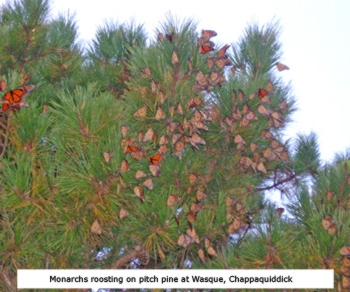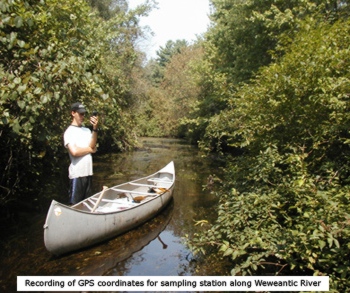Endangered Species/Biodiversity Conservation

E.O. Wilson, professor emeritus at Harvard University, predicts that unless we drastically alter our destruction of habitat and resultant loss of species, we will be seeing catastrophic results in 30 years. In keeping with its mission to protect the region’s biodiversity, the Lloyd Center contracts with state agencies, conservation groups and private individuals and corporations to conduct inventories on the distribution and abundance of a diverse array of animals including piping plovers, diamondback terrapins, salamanders, moths and butterflies, dragonflies and damselflies, and beetles. Increasingly, the Center is sought out by both state agencies and the private sector to conduct research on, or comment upon impacts of development on the region’s rare fauna. The following recent projects have contributed to an increased understanding and protection of the state’s most periled creatures.
Contracted Projects with the MA Natural Heritage and Endangered Species Program

During the past 20 years, the Lloyd Center has conducted more than 30 surveys of state-listed species across Massachusetts. Projects include:
- Monitoring & Management of Piping Plovers in Bristol County
- Insect (moths, butterflies, dragonflies, damselflies, tiger beetles) inventories across the state
- Vernal Pool Certification
- Marbled Salamander inventories
- Nantucket Lepidoptera Inventory
- Piping Plovers in Bristol County
- Winter Waterfowl
Examples of year-long surveys and collaborative projects:
SCUTES – SouthCoast Terrapin Survey. An informal consortium comprised of the Lloyd Center, the New Bedford Zoo, Dartmouth Natural Resources Trust, Massachusetts Audubon Society Allens Pond Sanctuary, the Dartmouth YMCA and Taber Academy was formed to address the lack of data on the state-threatened Diamondback Terrapin in Buzzards Bay. Two major populations, one in Marion and one in Dartmouth were discovered. Tabor Academy has been monitoring the Marion animals, and the Lloyd Center monitors the Dartmouth animals. The Lloyd Center also head-starts some of the hatchlings that emerge too late in the season to survive their first winter in the wild.

Inventory of Lepidoptera at Hodges Mill Village, Oxford MA (ongoing). Initiated in August, this survey of U.S.G.S property at a storm reservoir damming the French River covers a vast wetlands system and adjacent uplands. In three late summer/early fall trips, over 100 species of moths have been documented.
Lepidoptera Inventory on Chappaquiddick Island, Marthas Vineyard. Three hundred fifty-eight moths, including 12 state-listed species were documented on Chappaquiddick in 2006. Nine of the listed species were new records for the island. In addition, the pines at the southern end of the Wasque Preserve were documented as important roosts for migrating Monarch butterflies.
Inventory of Lepidoptera and tiger beetles at Camp Curtis Guild, Reading, MA. Three hundred thirty-nine species of macrolepidoptera were identified through this inventory. Most of the species encountered are common and/or widely distributed throughout the state. One listed (Special Concern) species was recorded: Itame undescr. sp., near “inextricata”. Forty-five species of butterflies and three tiger beetles were also documented during the course of this inventory.
 Distribution of the state-listed endemic moth, Papaipema sulphurata in the Herring River (Wellfleet) and salt Meadow (Truro) watersheds on Cape Cod. The Lloyd Center was contracted by the National Park Service to conduct a survey for this species, whose larval hostplant is water-willow (Decodon verticillatus). P. sulphurata (water-willow borer) is found only in five counties in southeastern Massachusetts.
Distribution of the state-listed endemic moth, Papaipema sulphurata in the Herring River (Wellfleet) and salt Meadow (Truro) watersheds on Cape Cod. The Lloyd Center was contracted by the National Park Service to conduct a survey for this species, whose larval hostplant is water-willow (Decodon verticillatus). P. sulphurata (water-willow borer) is found only in five counties in southeastern Massachusetts.
These data will be used to gauge the potential impacts of salt marsh restoration activities in these systems on P. sulphurata. Eighty records for P. sulphurata were found within 89 larval hostplant patches in the Herring River watershed, and 29 records were found within 17 hostplant patches at Salt Meadow. Thus, each of these systems supports a significant population of the state-listed P. sulphurata.

Survey of Freshwater Macroinvertebrates in Three Rivers (Westport, Paskamansett and Weweantic) flowing into Buzzards Bay. Over 100 aquatic invertebrates were documented, including the state listed damselfly, Enallagma pictum, and the amphipod, Synurella chamberlaini. Not only were there differences in community composition between habitats there were within-habitat differences between the three river systems. Fast water species composition within the Westport and Paskamansett systems was similar, especially among the Odonata and Trichoptera. However, the same habitat in the Weweantic River system had a dramatically different species composition. Dominant species groups in the Westport and Paskamansett – Trichoptera, Odonata, Plecoptera and Ephemeroptera – were absent or represented by only one species in the Weweantic. Although no nutrient data was taken, the Weweantic seemed to have a significantly higher nutrient load as evidenced by water clarity and amount of vegetation covering the rocks. The water also had a slight, but distinctive odor. The extensive cranberry operations that empty into this watershed may be supplying enough nutrients (and possibly pesticide residue) to negatively impact the invertebrate fauna in this system. The rapids and riffles particularly in parts of the Weweantic appear to be conducive for high macroinvertebrate diversity, yet the opposite was found.

Contracted Projects in Rhode Island
Establishment of a Butterfly baseline in a 28 acre field after restoration. In 2001, the Rhode Island division of The Nature Conservancy restored a 28 acre field in Charlestown, RI.
The Lloyd Center was contracted to set up and monitor five transects for butterfly distribution and abundance in the field in 2003.


Survey of Invertebrates in the Ponaganset watershed.
 In 2003, a disparate array of invertebrates was inventoried in the Ponaganset watershed. Of the 64 taxa of aquatic macroinvertebrates identified from 27 kick-net samples, no state-listed species were encountered; however the documentation of an Ophiogomphus mainensis nymph in the Ponaganset River is significant as a range extension and as documentation of larval habitat. The 46 adult Odonata documented within the Ponaganset watershed included the concern species, Enallagma laterale. The small overlap between adults and nymphs (10 species out of 46 total) of Odonata documented is due to the narrow scope (riverine habitats) of this survey.
In 2003, a disparate array of invertebrates was inventoried in the Ponaganset watershed. Of the 64 taxa of aquatic macroinvertebrates identified from 27 kick-net samples, no state-listed species were encountered; however the documentation of an Ophiogomphus mainensis nymph in the Ponaganset River is significant as a range extension and as documentation of larval habitat. The 46 adult Odonata documented within the Ponaganset watershed included the concern species, Enallagma laterale. The small overlap between adults and nymphs (10 species out of 46 total) of Odonata documented is due to the narrow scope (riverine habitats) of this survey.
Twenty-seven species of butterflies and 332 species of moths were documented within the Ponaganset watershed, including one concern species, Dusted Skipper (Atrytonopsis hianna). Other uncommon or locally distributed Lepidoptera documented in the Ponaganset watershed include: Milbert’s Tortoise Shell (Nymphalis milberti – Nymphalidae); Pepper and Salt Skipper (Amblyscrites hegon – Hesperiidae); Cepphis decoloraria and Plagodis kuetzingi (Geometridae); Datana contracta and Peridea basitriens (Notodontidae); and Eremobina jocasta (Noctuidae).

